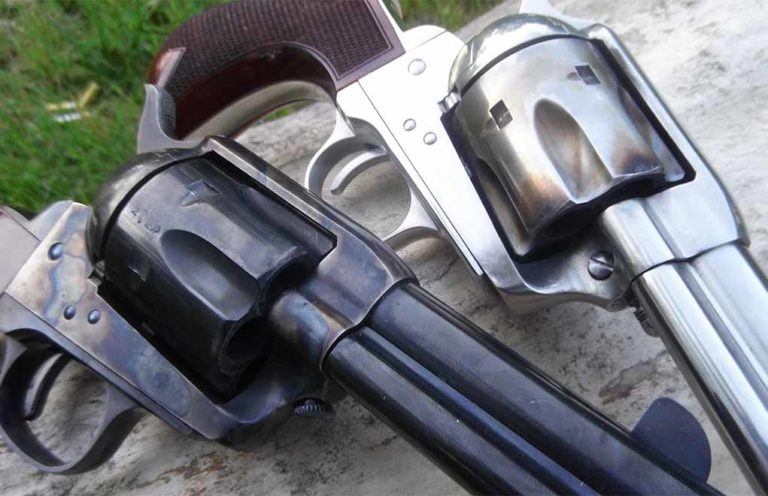
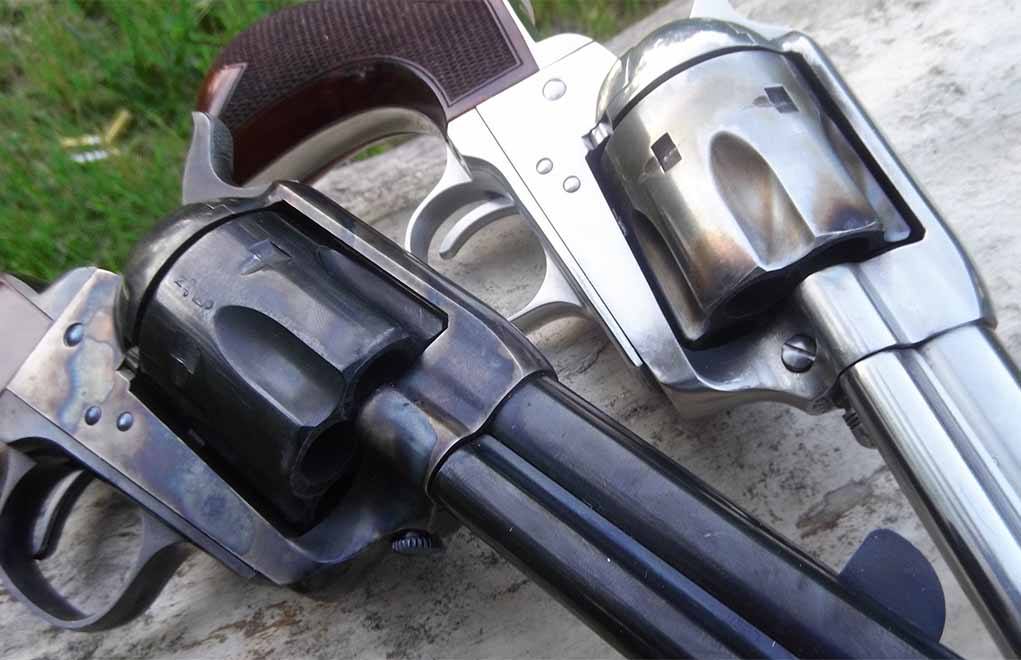
A blend of modern and classic, the Cimarron Thunderstorm Thunderer and New Sheriff are ideal for new-wave gunslingers.
What Makes These Modern Single-Action Army Revolvers Sweet Shooters:
- Both have 3 1/2-inch barrels
- They come available in .45 Colts, .44-40 and .38 Special/.357 Magnum
- The Thunderer has a stainless-steel finish, the Sheriff is blued
- The revolvers prove quick and accurate
There’s something that lies deep in the heart of every true, red-blooded American that can hear the call of the Old West. This is not something that everyone can sense in our modern age, but it draws the listener in—not just in mind, but in body. Reliving the tales and exploits of our heroes is only possible when you hold the same talismans they carried.
Cimarron Firearms has just what you need to feel right at home on a dusty street on your way to some dim, dirty saloon: the Cimarron Thunderstorm Thunderer 3½-inch stainless .45 Colt and the New Sheriff Model 3½-inch .45 Colt.
The two guns featured in this article are a blend of modern and classic. The materials might not be exactly the same as the guns of yesteryear; however, the function and handling are the same or better.
When people think of the Old West, the first thing that comes to mind for most is the duel in the street, where two men—sometimes rivals equal in just cause and other times, good and evil—face each other down.

These two Cimarron guns are perfect for the gunslinger: short, fast and deadly accurate.
Fast on the Draw
The classic tale has been repeated so many times that there are countless movies and songs written about it. Holstering one of these Cimarron revolvers makes you think of the Ranger in the Marty Robbins song, Big Iron: A brave Arizona Ranger kills a terrible outlaw named Texas Red. The song narrates a truly American story in which justice is served and evil is vanquished.
But just how did that Ranger get so fast on the draw?
Single-Action Army Revolver
The Old West was loaded with custom guns, but the quintessential firearm that surpassed all of them in fame was the Single-Action (SAA) Army revolver. The original SAAs were designed for military service in the era immediately following the Civil War. They saw combat across the West—most notably when they failed to avail George Custer at the Little Bighorn.
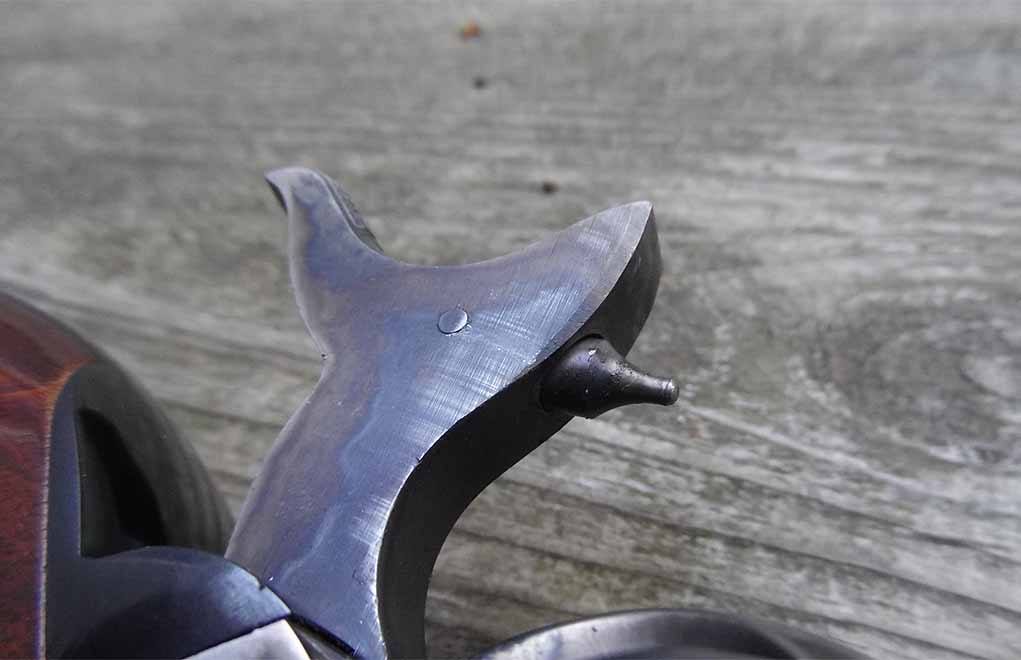
As is true of most innovative and successful designs adopted for military service (such as the 1911, M16/AR-15 and, most recently, the newly selected Sig Sauer M17), civilians grab on and make it their own thing. The arms issued by the military are often designed around some rather arbitrary goalposts that don’t concern civilian end users.
The original SAA in military service had a 7½-inch barrel that was much too long for the discerning quick-draw artist or someone looking to defend themselves on the street. The revolver came in at 13 inches in overall length but was capable of launching a 250-grain bullet at just shy of 1,000 fps with original .45 Colt black-powder loads.
Take Another Spin With Our Revolver Content:
- 7 Standout Concealed Carry Revolvers For Personal Defense
- Double-Action Revolver: Secret To The Trigger
- FBI Handguns: Revolvers of the Past
- Colt Python: The Cadillac Of Revolvers
While the military performance was excellent for the day and the type of fighting that was experienced, the benefits of the military SAA didn’t translate much for the civilian, who had need for a more compact, faster gun for close quarters and ease of carry, just as civilians do today. It could easily be argued that many a former cavalryman carried his 7½-inch gun, but the art and style of close-quarters gunfighting demanded something effective across the poker table, not across a battlefield.
The ‘Shopkeeper’
The earliest models that featured such short barrels were nicknamed the “shopkeeper” and lacked an ejector rod. While it is certainly possible that short-barreled revolvers were available with ejector rods at the time, the factory guns from Colt didn’t have one. Today’s shooters would shy away from a revolver with no means of quick ejection, so the Cimarron revolvers discussed in this article have an ejector rod that allows the case to be poked out—but it won’t expel them completely from the chamber as would a longer rod.
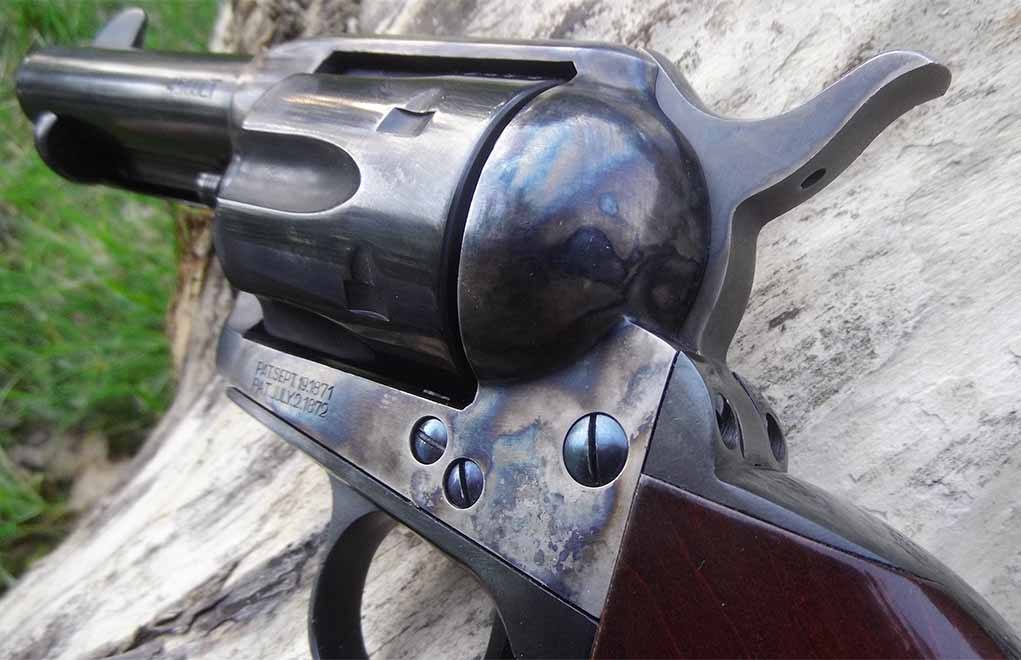
I found that simply tilting the revolvers at a slightly downward angle and then quickly tapping the ejector reliably kicks the fired brass all the way out … at least in most cases.
The Still-Relevant .45 Colt Cartridge
Both revolvers are chambered in .45 Colt. However, there’s a variety of other calibers available, including .44-40 and .38 Special/.357 Magnum. The choice of .45 Colt is both time-honored and practical in that while it was probably not the most common SAA chambering of its day for civilian use, it is historically and culturally relevant and is in ready supply today, where other classic chamberings are not.
The .45 Colt is a powerful cartridge, but it’s quite mild when other modern rounds are considered. While many readers might wonder who would carry or shoot a .45 Colt with a short barrel, it should be noted that a couple of the most popular revolvers from the last decades have been the Taurus Judge and Smith & Wesson Governor, both of which are chambered to fire .45 Colt and .410 shotshells out of 2.75-inch barrels. By comparison, the barrels on the Cimarron revolvers are long.
When considering .45 Colt loads for these two revolvers, many people will look to cast lead, but there are great jacketed options to consider as well.
Load Testing
For this article, I tested three different .45 Colt loads that are similar in some ways but wildly different in others. The three loads came from Black Hills Ammunition, Armscor and Sig Sauer. Each of them represents an era in technological development that’s helped the .45 Colt remain relevant in our modern era.
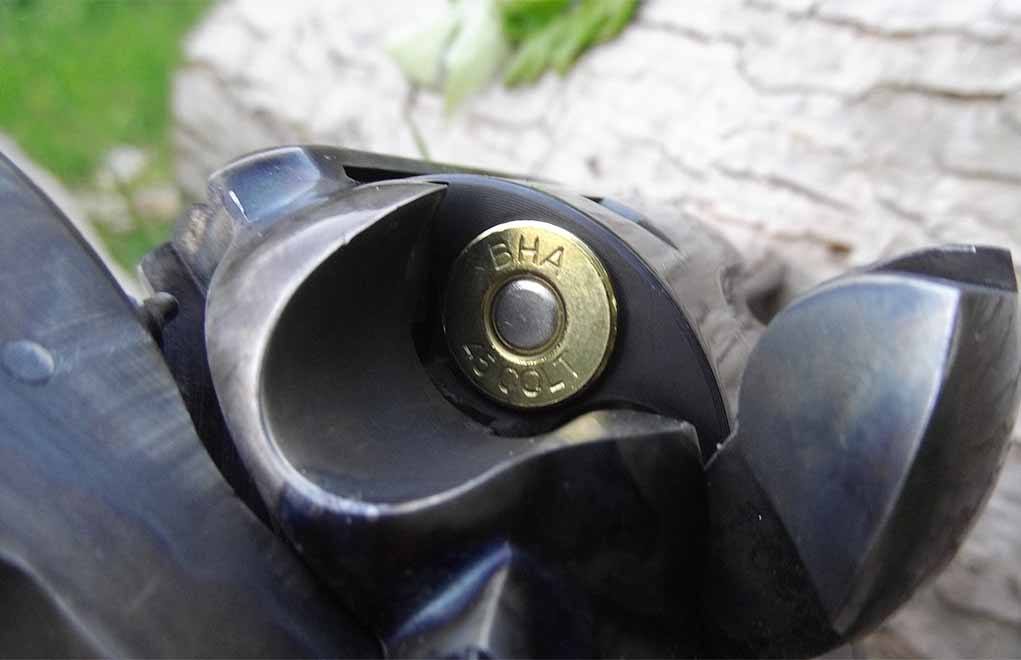
The Black Hills 250-grain RNFP Cowboy load is a classically modeled cartridge about as close to the original black-powder round you can get from a mainstream manufacturer. The bullet design is a typical round-nose flat-point; and, it has, over the course of the thousands I have fired, proven to be among the very best available for any gun chambered in .45 Colt.
The average velocity for the Black Hills load between the two Cimarron revolvers was 739 fps, with the velocity advantage of 5 fps going to the stainless Thunderstorm Thunderer. This load was the most pleasant to fire and the most accurate in general in both revolvers. It should be noted that while not quite as powerful as the original .45 Colt loads from the late 1800s, it’s extremely comparable and will deliver excellent terminal performance and penetration. Bullet technology has certainly moved on, but the good, old lead solid has never lost its abilities over time.
The next load was the Armscor 255-grain SWC. This ammo performed very well in both revolvers but delivered the slowest overall velocity (at an average of 721 fps), with a small variance again going to the Thunderstorm Thunderer in velocity. For all purposes, the two performed identically with this ammo.
This load features a semi-wadcutter profile. Nevertheless, where the profile of the projectile shoulder is concerned, upon further inspection, it resembles a Keith-style bullet. Keith-style bullets became popular in the mid-20th century as a means to improve the abilities of hunting revolvers. Elmer Keith has long been considered the “father of handgun hunting” in America, and the bullet style bears his name.
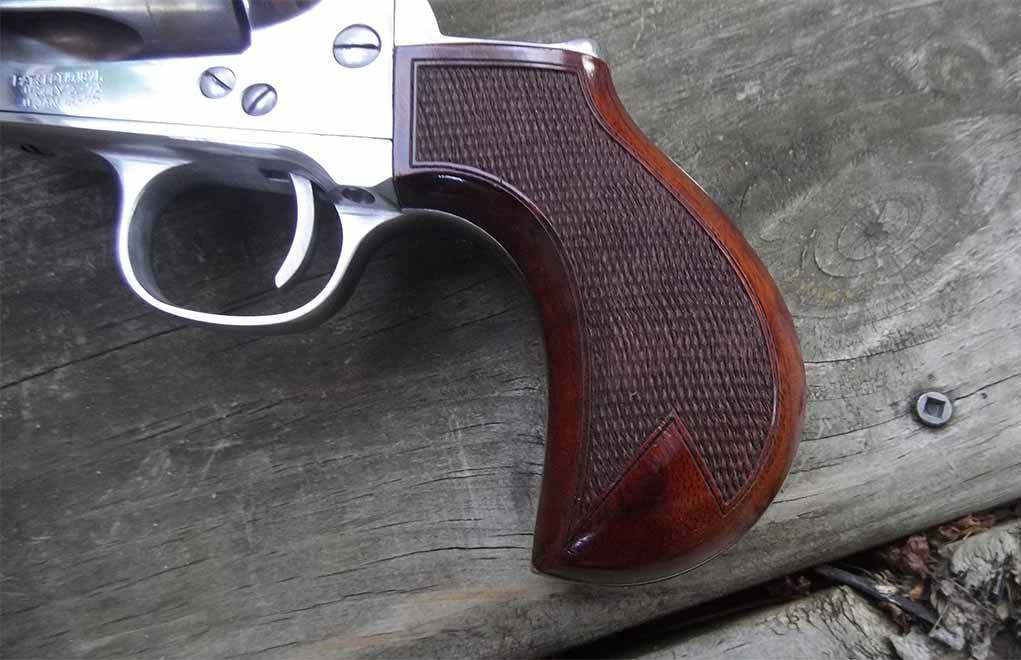
Armscor does a good job delivering quality ammo at low cost, but I found that the low speed hindered an otherwise great load that could, if it were a bit faster, be quite suitable for hunting and general outdoor use. Recoil was very low, and I had no issues putting lead on steel at any distance the guns were tested at.
Sig Sauer is new to the ammunition scene and has been making tremendous waves in many arenas. It seems that, to the ire of many legacy companies, Sig just can’t lose a contract these days; and, with its P320/M17 and P365 designs, it’s been showing Glock and others all around the world that there’s a “new sheriff in town.” Recently, Sig released CMP-grade ammunition for the .30-06 Springfield that features a 175-grain Sierra MatchKing bullet and is safe for use in the M1 Garand and 1903 Springfield rifles.
So, why is it that a progressive company such as Sig is taking risks on old news (the .30-06 and .45 Colt)? The answer lies in what’s at the heart of American shooting culture and its traditions.
The .45 Colt is as much a part of American culture as apple pie, and Sig was wise to invest, realizing that future generations will grow up with the company’s products front and center in military service and in the public mind.
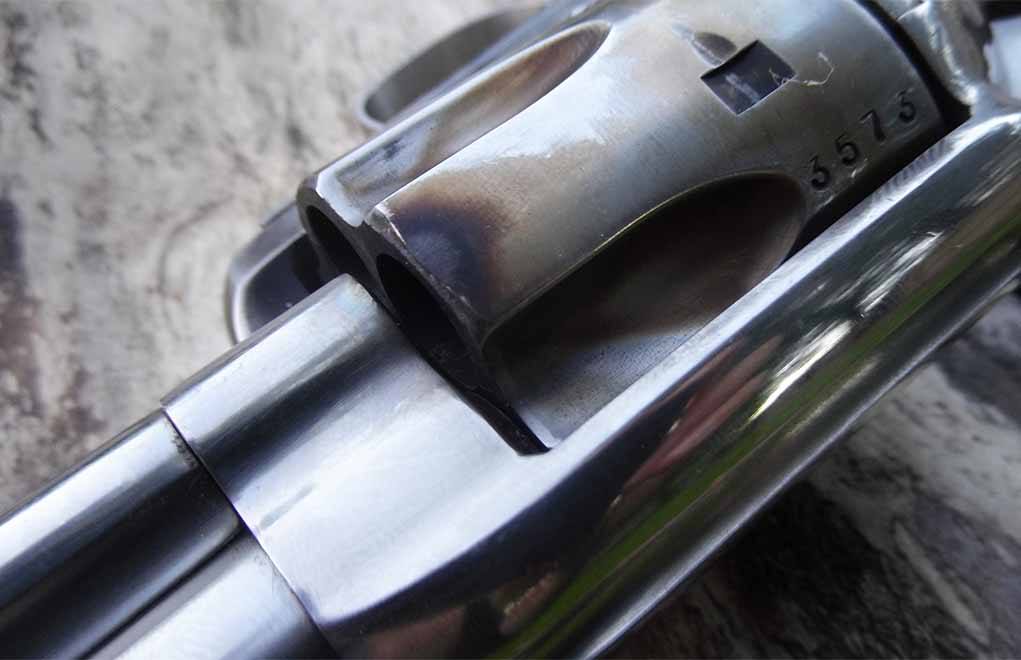
Sig’s 230-grain V-Crown JHP is a jacketed hollow-point that takes advantage of Sig’s advanced technology and manufacturing abilities. The bullet is designed to reliably expand in a variety of mediums and will deliver said expansion from short barrels, such as those popular on .45/.410 carry guns.
The modern construction of the Sig load makes it seem somewhat unnatural when loaded in a classic SAA, but the performance is stellar, and it makes for a serious self-defense load if someone decides to carry a gun chambered in .45 Colt. The velocity generated by the 230-grain V-Crown was 775 fps average from both revolvers—with a surprise velocity advantage given to the New Sheriff: 15 fps.
The Results
Accuracy with the .45 Colt in an SAA revolver is something that might elude modern shooters. The sights on both these guns are non-adjustable, with the front sights being fixed blades and the rear sights being notches machined into the top of the frames. Point of aim varies for each individual gun and load. The New Sheriff shot to point of aim at 15 yards but shot low at every range inside that. Group sizes for the New Sheriff were consistent, with all three loads producing identical accuracy averaging 4.5 inches at 25 yards for 10 shots off a rest.
The Thunderstorm Thunderer was a bit different and shot low and left at all ranges. Filing the front sight to raise point of impact is something that can be done to alter this, but it’s best done with a load that you want as a primary for competition or the outdoors. You wouldn’t be at an advantage to make permanent adjustments unless you’ve settled on a given load.
About the Revolvers
Despite sharing the same barrel length and chambering, the New Sheriff and Thunderstorm Thunderer are very different guns with very different purposes, but each has its own way of being fast and lethal.
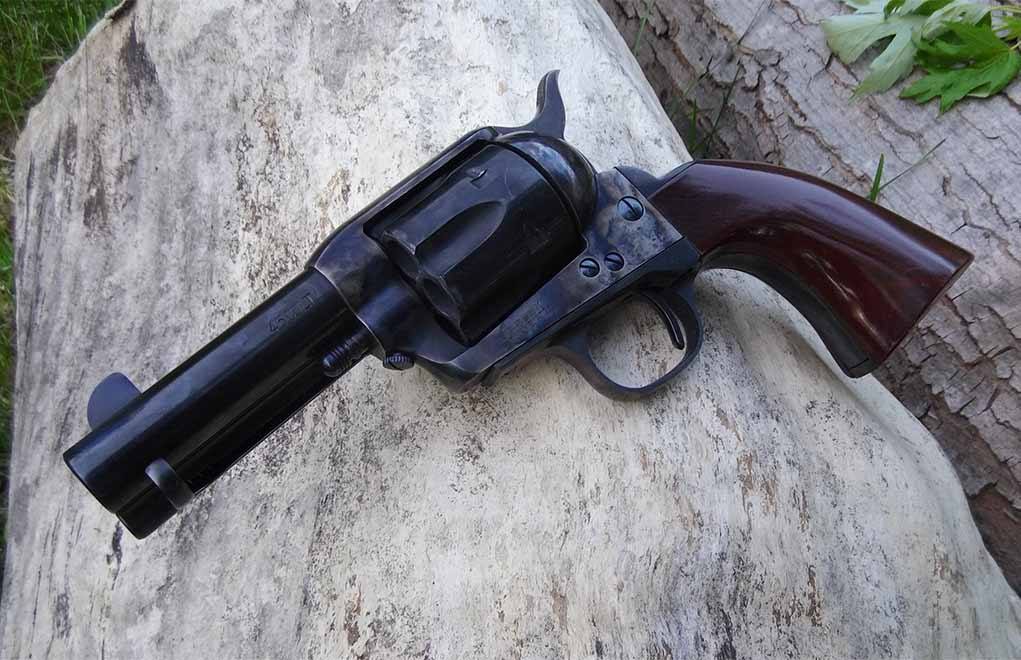
The New Sheriff has a full-sized grip made of walnut. The texture is smooth, and the finish is shiny and pleasing to the eye. I have large hands and found the grip to allow for a better purchase on the revolver under recoil. When hands get sweaty and temperatures rise, the smooth grip can get a bit slippery.
The hammer of the New Sheriff sports a traditional spur, and the lockwork of the revolver is traditional SAA. Trigger pull is light and crisp. There was the slightest amount of drag in the first 100 rounds or so. Nevertheless, this smoothed out with time.
An interesting point about the New Sheriff is that the frame is the Old Model P style. This means that the gun has a screw in the frame holding the base pin in. This style dates back to the first SAA revolvers in the early 1870s. Most modern SAA revolvers have the spring-loaded pin release common to models classified as “pre-war,” which were made from 1896 to 1940. (The Thunderstorm Thunderer has a pre-war frame for reference. The pre-war style is much easier to take apart, and there’s no risk of damaging the frame.)
The New Sheriff has a number of minute features that make it an exceptional gun for hard use. The finish of the gun is color case-hardened on the frame and hammer, while the cylinder and barrel are blued. The finish on my sample gun was even and well-applied. A recoil shield is present in the face of the frame. This feature adds strength to the frame and helps prevent deformation of the firing pin hole by dry-firing.

Overall, the New Sheriff saw about 1,200 rounds for this article—and there wasn’t a single failure to fire. I considered it to be among the fastest and easiest-to-point revolvers I’ve ever tested. The revolver was not cleaned at all during the entire testing; even so, it showed no problems. Care needed to be taken to prevent the screws from backing out, but a little bit of thread locker can take care of that should you desire.
If you’re looking for a fast-handling, classically styled .45 Colt that won’t break the bank, this gun has my recommendation. (MSRP: $566.32)
I would classify the Thunderstorm Thunderer as a modern gun in several respects. The grips are a “Doc Holliday”-style bird’s-head made of checkered walnut. The grip is comfortable and quick to handle, but I found it to be a little bit too small overall for precision shooting. Shooters with smaller hands or those looking for a gun that’s easier to conceal will enjoy this feature.
Mounted shooters will be happy to know that the Thunderstorm Thunderer is Cowboy Mounted Shooting Association (CMSA)-approved. The revolver has a lowered, widened hammer spur and an action job that lightens trigger pull, along with the force and effort needed to pull the hammer to the rear.
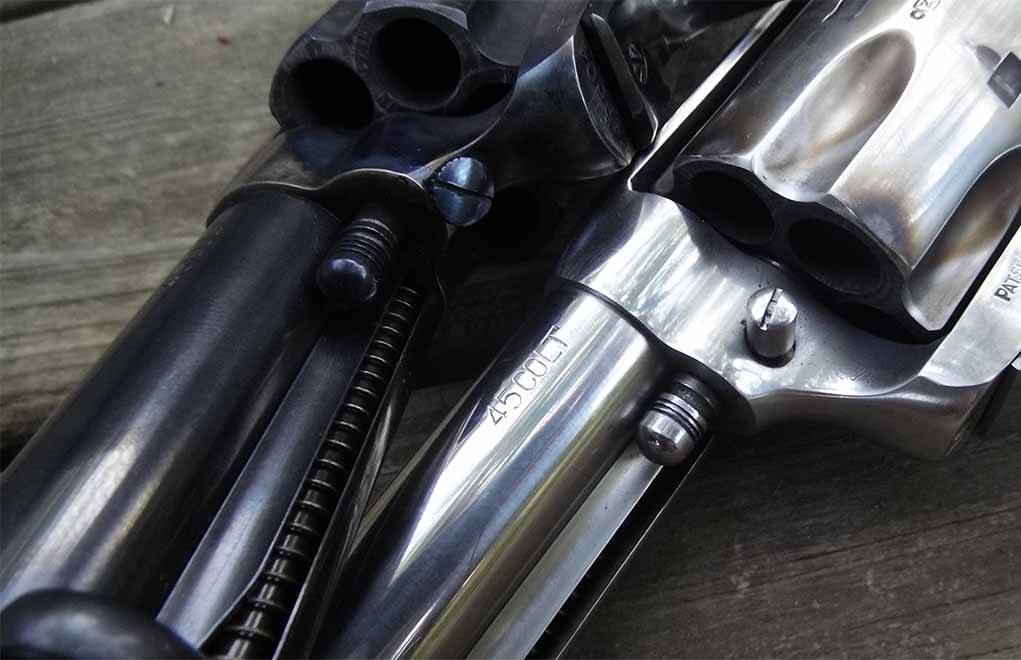
Trigger pull was much lighter than on the New Sheriff, but it wasn’t quite as crisp. Instead, it had a much more gradual pull that is preferable to action shooters looking for fast hits and not ultra-tight groups. This means that the Thunderer is exceptional for one-handed shooting. I found it to be faster to deploy from the holster and get lead on target than the New Sheriff … but only marginally so.
I fired 900 rounds through the Thunderstorm and didn’t have any significant issues with it—aside from a minor deformation of the firing pinhole. The revolver benefits from complete stainless steel construction, making it very durable overall. It also benefits from a hardened-steel recoil shield which, while somewhat unnecessary in an all-stainless gun, prevents burring around the firing pinhole.
Accuracy with the Thunderstorm was on par with that of the New Sheriff, but the bird’s-head grip made it difficult for me to print tight groups at 25 yards. Average accuracy was, again, equal for each of the three loads, tested at 5.3 inches for 10 shots at 25 yards. Point of impact varied slightly, with the Black Hills load shooting closer to point of aim than the Sig and Armscor loads. (MSRP: $975)
Shooting fast from a draw is a pleasure with both guns. There’s something so satisfying about spinning the cylinder on your Cimarron SAA and squaring up with some “outlaw.” Drawing from the hip and ringing steel put you right back in the Old West.
There are many types of SAA revolvers out there today, but not all are equal. If you want the best of the Old West, Cimarron has you covered.
The article originally appeared in the August 2019 issue of Gun Digest the Magazine.

Next Step: Get your FREE Printable Target Pack
Enhance your shooting precision with our 62 MOA Targets, perfect for rifles and handguns. Crafted in collaboration with Storm Tactical for accuracy and versatility.
Subscribe to the Gun Digest email newsletter and get your downloadable target pack sent straight to your inbox. Stay updated with the latest firearms info in the industry.

![Best Concealed Carry Guns In 2025 [Field Tested] Wilson Combat EDC X9S 1](https://gundigest.com/wp-content/uploads/Wilson-Combat-EDC-X9S-1-324x160.jpg)


![Best 9mm Carbine: Affordable PCCs [Tested] Ruger Carbine Shooting](https://gundigest.com/wp-content/uploads/Ruger-Carbine-Shooting-100x70.jpg)
![Best AR-15: Top Options Available Today [Field Tested] Harrington and Richardson PSA XM177E2 feature](https://gundigest.com/wp-content/uploads/Harrington-and-Richardson-PSA-XM177E2-feature-100x70.jpg)
